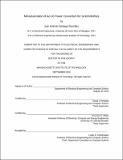Miniaturization of Ac-Dc power converters for grid interface
Author(s)
Santiago-González, Juan Antonio
DownloadFull printable version (6.969Mb)
Alternative title
Miniaturization of Alternating Current- Direct Current power converters for grid interface
Other Contributors
Massachusetts Institute of Technology. Department of Electrical Engineering and Computer Science.
Advisor
David J. Perreault and Khurram K. Afridi.
Terms of use
Metadata
Show full item recordAbstract
In this thesis we present a two-stage ac/dc grid-connected converter for computer applications. Also known as off-line power supplies, these converters have to meet various demanding specifications such as a wide input voltage range (typically 0-376 V), large voltage step down (typical output voltages range from 12-48 V), harmonic current limits and galvanic isolation. The focus of this work is in the reduction in volume of ac/dc converters while keeping efficiency constant or improving it, which is challenging to achieve while meeting all the specifications. The thesis breaks down the converter in subsystems and explores architectural and topological trade-offs, modeling, component selection and control methods. The performance of each individual subsystem is experimentally verified. The first stage of the converter is a step-down power factor correction (PFC) converter. This stage interacts with the grid and draws the necessary ac power from the line and rectifies it. Following the PFC is a capacitor bank, which is used to both buffer the ac power from the line and to provide hold-up energy to the output. The capacitor selection process is detailed in the thesis. The second stage of the converter provides isolation and regulation to the output. Two different approaches to the second stage converter are presented: using commercially available, "plug and play" converters and developing a custom converter. The full system is evaluated with both solutions and is compared to other state of the art converters. The final prototype achieves an efficiency of 95.33% at full power (250 W) and 230 Vac input, and a power density of 35 W/in3.
Description
Thesis: Ph. D., Massachusetts Institute of Technology, Department of Electrical Engineering and Computer Science, 2018. This electronic version was submitted by the student author. The certified thesis is available in the Institute Archives and Special Collections. Cataloged from student-submitted PDF version of thesis. Includes bibliographical references (pages 185-189).
Date issued
2018Department
Massachusetts Institute of Technology. Department of Electrical Engineering and Computer SciencePublisher
Massachusetts Institute of Technology
Keywords
Electrical Engineering and Computer Science.